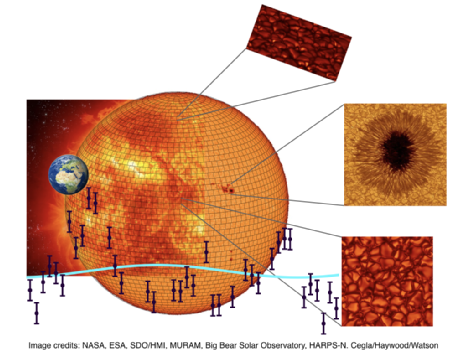Heather Cegla
Since the confirmation of the first planets outside our solar system in the 1990s, we have made tremendous progress towards answering this question. Yet, the confirmation of a true Earth-analogue still evades us. On top of this, if we are truly to understand the origins of life in the cosmos, we must also create a complete picture of planetary formation, evolution, and habitability.
However, each of these aspects necessitates a detailed knowledge of solar-type stars. This is because we study exoplanets indirectly by analysing their much more luminous host stars. For example, most planet confirmation relies on the Doppler wobble of the host star, induced by the planet. Moreover, we can learn about a planet's dynamical history from mapping its projected orbit as it transits its host star. Hence, stellar surface inhomogeneities can impact planetary interpretations, and can completely swamp the signals from rocky worlds.
My research, as a UKRI Future Leaders Fellow, aims to overcome these hurdles. For this, I study stellar surfaces from a two-pronged approach: with state-of-the-art 3D simulations and using transiting planets to empirically probe stellar surfaces.

Our goal is to understand and disentangle a fundamental barrier on the pathway to confirming other Earths: the stellar surface inhomogeneities from convection. Planet confirmation requires a mass measurement, which can be determined from the Doppler shift of the absorption lines in the stellar atmosphere. However, all Sun-like stars are enveloped in boiling plasma, causing hot bubbles of plasma to rise to the surface (inducing blueshifts), where they cool and fall down into the surrounding regions (inducing redshifts). The net result is spurious velocity shifts up to a m/s - completely swamping the tiny signal of an Earth- twin, which is a mere 9 cm/s. These shifts can be even larger if regions of magnetic field concentrate and inhibit the convection. Moreover, as the next generation of spectrographs (e.g. ESPRESSO) come online we are entering an era where it is technologically feasible to detect an Earth-twin signal, making this work extremely time critical.
The Sun has shown us convection does not easily average out; we must disentangle its signature to find Earth-like worlds. To do this, my group use's 3D magnetohydrodynamic simulations to create realistic model stars. With these, we study precisely how convection alters stellar lines, and work to optimise stellar noise reduction techniques. My precursor work on Solar- analogues indicates we can use the curvature of the stellar lines to remove this noise, but will this work for hotter or cooler stars? How do noise diagnostics behave if a star has a patchy distribution of magnetic field? Which lines are most sensitive to the convection and magnetic fields? These are some of the questions my research aims to answer in the next four to seven years.
Of course, these diagnostics are only as reliable as their underlying simulations. I have pioneered a new technique, using transiting planets as probes, to validate these for the first time for main-sequence stars other than the Sun. By subtracting in- from out-of-transit observations, we isolate the starlight behind the planet. With this, we can study the convection behaviour, stellar differential rotation, and determine the 3D trajectory of a planet's orbit - a key feature in understanding its formation and evolution. By applying this technique to a range of systems we will validate the simulations, quantify the impact of convection on planetary dynamic measurements, and contribute to a more global understanding of planet formation and evolution.
With this two-pronged approach, my group aims to push the frontiers of astronomy towards the future confirmation and characterisation of habitable alien worlds, and help answer whether or not we are truly alone in the Universe.
Feel free to check out more at my personal page: https://hcegla.weebly.com/
Write to:
Dr H. M. CeglaContact details:
Towards Other Earths team at Warwick:
Dr H. M. Cegla; Group Lead
G. FrameLink opens in a new window, PhD Candidate
Dr V. PanwarLink opens in a new window, Postdoctoral Research Fellow
Dr V. KunovacLink opens in a new window, Postdoctoral Research Fellow
Collaborators:
Dr L. DoyleLink opens in a new window; Postdoctoral Research Fellow
Dr M. Lafarga MagroLink opens in a new window; Postdoctoral Research Fellow
